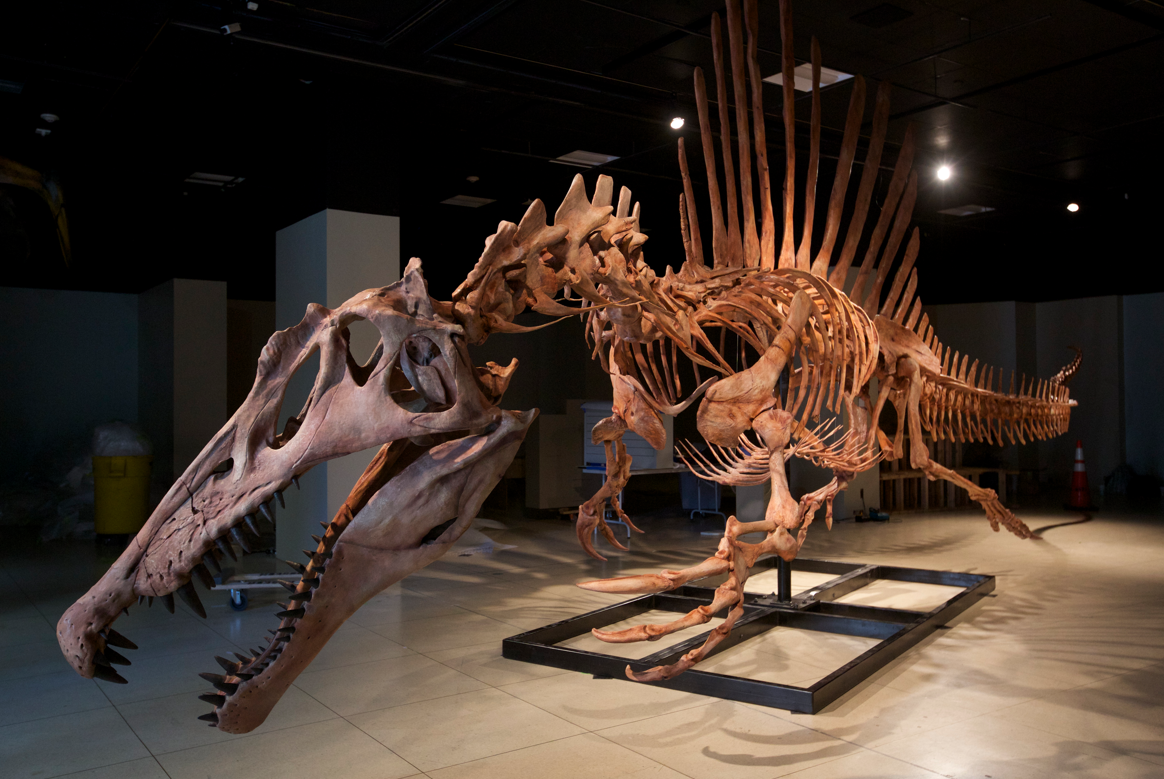Today, the National Geographic Museum unveiled the exhibition “Spinosaurus: Lost Giant of the Cretaceous,” featuring a life-sized skeletal model of Spinosaurus, the first truly semiaquatic dinosaur and the largest predatory dinosaur known to have roamed the Earth. At more than 50 feet long and 20 feet high, Spinosaurus measured more than 9 feet longer than the world’s largest Tyrannosaurus rex. The life-size skeletal model is the commanding centerpiece of this new exhibition developed by the National Geographic Society in collaboration with the University of Chicago. A life-size flesh replica of this colossal creature can be seen in National Geographic’s courtyard, on M Street between 16th and 17th Streets, N.W. The “Spinosaurus” exhibition will remain open at the National Geographic Museum until April 12, 2015.
In addition to the massive skeletal model, created by using 3D digital printing technology, the exhibition brings to life the fascinating backstory of Spinosaurus, which began more than a century ago when German paleontologist Ernst Freiherr Stromer von Reichenbach first discovered evidence of the dinosaur in the Egyptian Sahara.
During the April 1944 Allied bombing of Munich, Germany, Stromer’s important fossil collection was completely destroyed. Fortunately, some of Stromer’s notes, sketches and photos survived, along with his scientific publications. Inspired by Stromer’s work and legacy, University of Chicago paleontologist Nizar Ibrahim, a 2014 National Geographic Emerging Explorer, began his own search for Spinosaurus. The hunt led Ibrahim to a site in the Moroccan Sahara where a partial skeleton of Spinosaurus was found in 2008. More recently, with funding from the National Geographic Society, Ibrahim and paleontologist Paul Sereno, head of the University of Chicago’s Fossil Lab, worked with a team of paleontologists, including Cristiano Dal Sasso and Simone Maganuco from the Natural History Museum in Milan, Italy, and Samir Zouhri from Université Hassan II Casablanca in Morocco, to analyze the new fossils and create a digital model of the skeleton using state-of-the-art technologies.
“This exhibition is a fascinating tale of modern discovery and a trip back 95 million years in time to what was probably the most dangerous place on Earth,” said Kathryn Keane, vice president of National Geographic Exhibitions. “Thanks to science, we now know that the windswept and barren Sahara was once teeming with gigantic and terrifying predatory creatures, and Spinosaurus was the biggest and the baddest of them all.”
Museum visitors will follow the saga of Spinosaurus all the way from Stromer’s Munich office during the turbulence of World War II to Sereno’s Fossil Lab in present-day Chicago. The interactive, multimedia exhibit takes visitors on a journey spanning decades and continents, culminating with the reveal of the massive skeletal model of Spinosaurus, displayed in an immersive environment with other species from the Cretaceous period and featuring beautiful scientific mural illustrations by Italian artist Davide Bonadonna. The skeletal mount, based on a digital model built at the University of Chicago from CT scans of the fossils, was printed and mounted by Research Casting in Toronto. GeoModel, in Milan, Italy, created the full-sized flesh model. Museum guests will also have the opportunity to get up close and personal with real dinosaur fossils and learn about the latest technologies that modern paleontologists use in the field and the lab.
The National Geographic Museum’s dinosaur-themed offerings continue with screenings of the films “Sea Monsters: A Prehistoric Adventure 3D” and “Flying Monsters 3D” on Saturdays and Sundays at 12 p.m., 1 p.m., 2 p.m. and 3 p.m. Additionally, future paleontologists will love the “Discover Dinosaurs Birthday Parties” available on weekends for kids ages 5 through 12. Young explorers will be invited on their own dinosaur expedition, including a hands-on paleontology project, dinosaur scavenger hunt and other dino-themed games and activities. The museum will also offer daily tours of the exhibition at 11:30 a.m. and 2:30 p.m.
Ibrahim and Sereno will share the incredible story behind Spinosaurus with National Geographic Live audiences on Thursday, Oct. 16. The National Geographic Museum will stay open late that evening to give Nat Geo Live ticketholders the opportunity to visit the exhibit before the event. Tickets start at $24 and can be purchased at www.nglive.org/dc.
The global search to uncover the Spinosaurus skeleton and its mysteries will be featured as the cover story of the October issue of National Geographic magazine as well as in a National Geographic/NOVA special, “Bigger Than T. rex,” airing on PBS on Nov. 5, 2014, at 9 p.m.
Also open in the museum’s 17th Street galleries is “Peruvian Gold: Ancient Treasures Unearthed,” which will close on Sunday, Sept. 14. “Food: Our Global Kitchen” will open in that space on Oct. 16. “Mars Up Close” is on display in the museum’s M Street gallery now through Nov. 30.
The National Geographic Museum, 1145 17th Street, N.W., Washington, D.C., is open every day from 10 a.m. to 6 p.m. Though the photography exhibitions in the museum’s M Street gallery and outdoors are free, the exhibitions in the 17th Street galleries are ticketed. Admission is $11 for adults; $9 for National Geographic members, military, students, seniors and groups of 25 or more; $7 for children 5-12; and free for local school, student and youth groups (18 and under; advance reservation required). Tickets may be purchased online at www.ngmuseum.org; via telephone at (202) 857-7700; or in person at the National Geographic ticket booth, 1145 17th Street M Street, N.W., between 9 a.m. and 5 p.m. For more information on group sales, call (202) 857-7281 or email [email protected].








